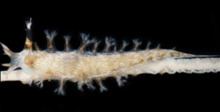Kingdom Animalia Superfamily Tritonioidea Genus Tritonia Phylum Mollusca | Class Gastropoda Family Tritoniidae Scientific name Tritonia hamnerorum Rank Species | |
 | ||
Similar Tritonia, Aphelodoris, Tritoniidae, Tritoniopsis elegans, Gorgonia ventalina | ||
Tritonia hamnerorum front view
Tritonia hamnerorum is a species of dendronotid nudibranch. It is a marine gastropod mollusc in the family Tritoniidae.
Contents
- Tritonia hamnerorum front view
- Tritonia hamnerorum p7220275
- Distribution
- Description
- Habitat
- Feeding habits
- Life cycle
- References
Tritonia hamnerorum p7220275
Distribution
Tritonia hamnerorum is found in the Caribbean area with its range extending from the Gulf of Mexico to Curaçao and the Cayman Islands. The distribution of Tritonia hamnerorum includes Florida, Mexico, Belize, Bahamas, Cayman Islands and Panama.
Description
The shape of the body elongate and narrow. Rhinophoral sheaths are elevated with an irregular edge. Cerata are short and branched. Edge of the oral veil is with relatively long appendages. Rhinophores ar long and branched. Background color is translucent gray with a series of irregular, longitudinal, thin white lines that run along the length of the dorsum. Its colour, pink or pale lavender, matches the colour of its host sea fan, Gorgonia ventalina. There are about twenty thin white stripes running the length of the body. There are series of nine, sparsely pinnate, gills down each side of the body. Tritonia hamnerorum is up to 15 millimetres (0.59 in) long.
Habitat
It is found in the shallow water and reef habitats as its host Gorgonia ventalina. Minimum recorded depth is 2 m. Maximum recorded depth is 4 m.
Feeding habits
Tritonia hamnerorum seems to feed exclusively on Gorgonia ventalina and extensive searches failed to locate any individuals on other parts of the reef, on mangroves or in seagrass beds. Gorgonia ventalina contains secondary metabolites including one, "julieannafuran", which is distasteful to predators. Tritonia hamnerorum seems to be unaffected by this and sequesters the compound, accumulating it in its tissues. This in turn makes the nudibranch distasteful to predatory fish, such as the bluehead wrasse (Thalassoma bifasciatum), which avoid consuming this species. This species reportedly feeds on the octocorals Gorgonia ventalina and Gorgonia flabellum.
Life cycle
This nudibranch lays small clusters containing several hundred egg capsules on branches of its host coral. The morphology of the veliger larvae that hatch from these eggs suggest that they are planktonic. Juveniles feed on the soft tissue overlying the skeleton of the sea fan while adults feed on the polyps. Within its range, the distribution of Tritonia hamnerorum is very patchy. Usually one or a few individuals are found on a single sea fan, but very occasionally, as happened in an outbreak in 1992, a large number of juveniles occur. On this occasion, 1,700 were found in a dense aggregation on one side of an area of sea fan measuring 0.27 square metres (2.9 sq ft). Because these juveniles were all the same size, researchers hypothesized that they may not have become planktonic but may have remained on the host after hatching and fed on plankton, like their host, before undergoing metamorphosis. It was found on gorgonian sea fans in dense aggregations also in Panama.
